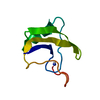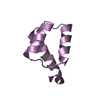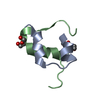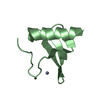+ Open data
Open data
- Basic information
Basic information
| Entry | Database: PDB / ID: 2kxk | ||||||
|---|---|---|---|---|---|---|---|
| Title | Human Insulin Mutant A22Gly-B31Lys-B32Arg | ||||||
 Components Components |
| ||||||
 Keywords Keywords |  HORMONE / HORMONE /  Human Insulin / Human Insulin /  Mutant / water/acetonitrile solution Mutant / water/acetonitrile solution | ||||||
| Function / homology |  Function and homology information Function and homology informationnegative regulation of NAD(P)H oxidase activity / negative regulation of glycogen catabolic process / regulation of cellular amino acid metabolic process / Signaling by Insulin receptor / IRS activation / nitric oxide-cGMP-mediated signaling / negative regulation of fatty acid metabolic process / Insulin processing / negative regulation of feeding behavior /  regulation of protein secretion ...negative regulation of NAD(P)H oxidase activity / negative regulation of glycogen catabolic process / regulation of cellular amino acid metabolic process / Signaling by Insulin receptor / IRS activation / nitric oxide-cGMP-mediated signaling / negative regulation of fatty acid metabolic process / Insulin processing / negative regulation of feeding behavior / regulation of protein secretion ...negative regulation of NAD(P)H oxidase activity / negative regulation of glycogen catabolic process / regulation of cellular amino acid metabolic process / Signaling by Insulin receptor / IRS activation / nitric oxide-cGMP-mediated signaling / negative regulation of fatty acid metabolic process / Insulin processing / negative regulation of feeding behavior /  regulation of protein secretion / positive regulation of peptide hormone secretion / regulation of protein secretion / positive regulation of peptide hormone secretion /  Regulation of gene expression in beta cells / positive regulation of respiratory burst / positive regulation of dendritic spine maintenance / alpha-beta T cell activation / negative regulation of acute inflammatory response / negative regulation of respiratory burst involved in inflammatory response / negative regulation of protein secretion / fatty acid homeostasis / Synthesis, secretion, and deacylation of Ghrelin / positive regulation of glycogen biosynthetic process / positive regulation of lipid biosynthetic process / Signal attenuation / FOXO-mediated transcription of oxidative stress, metabolic and neuronal genes / negative regulation of gluconeogenesis / positive regulation of nitric oxide mediated signal transduction / regulation of protein localization to plasma membrane / COPI-mediated anterograde transport / negative regulation of lipid catabolic process / negative regulation of oxidative stress-induced intrinsic apoptotic signaling pathway / negative regulation of reactive oxygen species biosynthetic process / positive regulation of insulin receptor signaling pathway / Regulation of gene expression in beta cells / positive regulation of respiratory burst / positive regulation of dendritic spine maintenance / alpha-beta T cell activation / negative regulation of acute inflammatory response / negative regulation of respiratory burst involved in inflammatory response / negative regulation of protein secretion / fatty acid homeostasis / Synthesis, secretion, and deacylation of Ghrelin / positive regulation of glycogen biosynthetic process / positive regulation of lipid biosynthetic process / Signal attenuation / FOXO-mediated transcription of oxidative stress, metabolic and neuronal genes / negative regulation of gluconeogenesis / positive regulation of nitric oxide mediated signal transduction / regulation of protein localization to plasma membrane / COPI-mediated anterograde transport / negative regulation of lipid catabolic process / negative regulation of oxidative stress-induced intrinsic apoptotic signaling pathway / negative regulation of reactive oxygen species biosynthetic process / positive regulation of insulin receptor signaling pathway /  transport vesicle / positive regulation of protein autophosphorylation / Insulin receptor recycling / transport vesicle / positive regulation of protein autophosphorylation / Insulin receptor recycling /  insulin-like growth factor receptor binding / NPAS4 regulates expression of target genes / positive regulation of protein metabolic process / neuron projection maintenance / endoplasmic reticulum-Golgi intermediate compartment membrane / positive regulation of brown fat cell differentiation / activation of protein kinase B activity / positive regulation of glycolytic process / Insulin receptor signalling cascade / positive regulation of mitotic nuclear division / Regulation of insulin secretion / positive regulation of nitric-oxide synthase activity / positive regulation of long-term synaptic potentiation / endosome lumen / positive regulation of cytokine production / acute-phase response / positive regulation of protein secretion / regulation of transmembrane transporter activity / positive regulation of cell differentiation / positive regulation of glucose import / negative regulation of proteolysis / insulin-like growth factor receptor binding / NPAS4 regulates expression of target genes / positive regulation of protein metabolic process / neuron projection maintenance / endoplasmic reticulum-Golgi intermediate compartment membrane / positive regulation of brown fat cell differentiation / activation of protein kinase B activity / positive regulation of glycolytic process / Insulin receptor signalling cascade / positive regulation of mitotic nuclear division / Regulation of insulin secretion / positive regulation of nitric-oxide synthase activity / positive regulation of long-term synaptic potentiation / endosome lumen / positive regulation of cytokine production / acute-phase response / positive regulation of protein secretion / regulation of transmembrane transporter activity / positive regulation of cell differentiation / positive regulation of glucose import / negative regulation of proteolysis /  regulation of synaptic plasticity / regulation of synaptic plasticity /  wound healing / wound healing /  insulin receptor binding / negative regulation of protein catabolic process / positive regulation of neuron projection development / insulin receptor binding / negative regulation of protein catabolic process / positive regulation of neuron projection development /  hormone activity / hormone activity /  cognition / Golgi lumen / cognition / Golgi lumen /  vasodilation / positive regulation of protein localization to nucleus / glucose metabolic process / vasodilation / positive regulation of protein localization to nucleus / glucose metabolic process /  regulation of protein localization / regulation of protein localization /  glucose homeostasis / cell-cell signaling / insulin receptor signaling pathway / positive regulation of NF-kappaB transcription factor activity / PI5P, PP2A and IER3 Regulate PI3K/AKT Signaling / positive regulation of cell growth / secretory granule lumen / glucose homeostasis / cell-cell signaling / insulin receptor signaling pathway / positive regulation of NF-kappaB transcription factor activity / PI5P, PP2A and IER3 Regulate PI3K/AKT Signaling / positive regulation of cell growth / secretory granule lumen /  protease binding / positive regulation of MAPK cascade / positive regulation of phosphatidylinositol 3-kinase/protein kinase B signal transduction / positive regulation of cell migration / G protein-coupled receptor signaling pathway / Amyloid fiber formation / protease binding / positive regulation of MAPK cascade / positive regulation of phosphatidylinositol 3-kinase/protein kinase B signal transduction / positive regulation of cell migration / G protein-coupled receptor signaling pathway / Amyloid fiber formation /  endoplasmic reticulum lumen / endoplasmic reticulum lumen /  Golgi membrane / negative regulation of gene expression / positive regulation of cell population proliferation / positive regulation of gene expression / regulation of DNA-templated transcription / Golgi membrane / negative regulation of gene expression / positive regulation of cell population proliferation / positive regulation of gene expression / regulation of DNA-templated transcription /  extracellular space / extracellular region / identical protein binding extracellular space / extracellular region / identical protein bindingSimilarity search - Function | ||||||
| Biological species |   Homo sapiens (human) Homo sapiens (human) | ||||||
| Method |  SOLUTION NMR / SOLUTION NMR /  simulated annealing simulated annealing | ||||||
| Model details | lowest energy, model 1 | ||||||
 Authors Authors | Bocian, W. / Kozerski, L. | ||||||
 Citation Citation |  Journal: To be Published Journal: To be PublishedTitle: Novel recombinant insulin analogue with flexible C - terminus in B chain. NMR structure of biosynthetic engineered A22G-B31K-B32R human insulin monomer in water /acetonitrile solution. Authors: Borowicz, P. / Mikolajczyk, J. / Bocian, W. / Sitkowski, J. / Bednarek, E. / Jaworska, D. / Blazej, S. / Bogiel, M. / Mikiewicz-Sygula, D. / Kurzynoga, D. / Kozerski, L. | ||||||
| History |
|
- Structure visualization
Structure visualization
| Structure viewer | Molecule:  Molmil Molmil Jmol/JSmol Jmol/JSmol |
|---|
- Downloads & links
Downloads & links
- Download
Download
| PDBx/mmCIF format |  2kxk.cif.gz 2kxk.cif.gz | 326.1 KB | Display |  PDBx/mmCIF format PDBx/mmCIF format |
|---|---|---|---|---|
| PDB format |  pdb2kxk.ent.gz pdb2kxk.ent.gz | 284.7 KB | Display |  PDB format PDB format |
| PDBx/mmJSON format |  2kxk.json.gz 2kxk.json.gz | Tree view |  PDBx/mmJSON format PDBx/mmJSON format | |
| Others |  Other downloads Other downloads |
-Validation report
| Arichive directory |  https://data.pdbj.org/pub/pdb/validation_reports/kx/2kxk https://data.pdbj.org/pub/pdb/validation_reports/kx/2kxk ftp://data.pdbj.org/pub/pdb/validation_reports/kx/2kxk ftp://data.pdbj.org/pub/pdb/validation_reports/kx/2kxk | HTTPS FTP |
|---|
-Related structure data
| Similar structure data |
|---|
- Links
Links
- Assembly
Assembly
| Deposited unit | 
| |||||||||
|---|---|---|---|---|---|---|---|---|---|---|
| 1 |
| |||||||||
| NMR ensembles |
|
- Components
Components
| #1: Protein/peptide | Mass: 2440.750 Da / Num. of mol.: 1 Source method: isolated from a genetically manipulated source Source: (gene. exp.)   Homo sapiens (human) / Gene: INS / Production host: Homo sapiens (human) / Gene: INS / Production host:   Escherichia coli (E. coli) / References: UniProt: P01308 Escherichia coli (E. coli) / References: UniProt: P01308 |
|---|---|
| #2: Protein/peptide | Mass: 3720.326 Da / Num. of mol.: 1 / Mutation: R31K Source method: isolated from a genetically manipulated source Source: (gene. exp.)   Homo sapiens (human) / Gene: INS / Production host: Homo sapiens (human) / Gene: INS / Production host:   Escherichia coli (E. coli) / References: UniProt: P01308 Escherichia coli (E. coli) / References: UniProt: P01308 |
-Experimental details
-Experiment
| Experiment | Method:  SOLUTION NMR SOLUTION NMR | ||||||||||||||||
|---|---|---|---|---|---|---|---|---|---|---|---|---|---|---|---|---|---|
| NMR experiment |
|
- Sample preparation
Sample preparation
| Details |
| |||||||||
|---|---|---|---|---|---|---|---|---|---|---|
| Sample |
| |||||||||
| Sample conditions | Ionic strength: 0 / pH: 3.5 / Pressure: ambient / Temperature: 298 K |
-NMR measurement
| NMR spectrometer | Type: Varian Uniform NMR System / Manufacturer: Varian / Model : Uniform NMR System / Field strength: 500 MHz : Uniform NMR System / Field strength: 500 MHz |
|---|
- Processing
Processing
| NMR software |
| ||||||||||||||||||||||||
|---|---|---|---|---|---|---|---|---|---|---|---|---|---|---|---|---|---|---|---|---|---|---|---|---|---|
| Refinement | Method:  simulated annealing / Software ordinal: 1 simulated annealing / Software ordinal: 1 | ||||||||||||||||||||||||
| NMR constraints | NOE constraints total: 700 / NOE intraresidue total count: 230 / NOE long range total count: 35 / NOE medium range total count: 150 / NOE sequential total count: 235 / Protein chi angle constraints total count: 159 / Protein phi angle constraints total count: 37 / Protein psi angle constraints total count: 37 | ||||||||||||||||||||||||
| NMR representative | Selection criteria: lowest energy | ||||||||||||||||||||||||
| NMR ensemble | Conformer selection criteria: structures with the least restraint violations Conformers calculated total number: 100 / Conformers submitted total number: 20 / Maximum upper distance constraint violation: 1.15 Å / Representative conformer: 1 |
 Movie
Movie Controller
Controller













 PDBj
PDBj

















